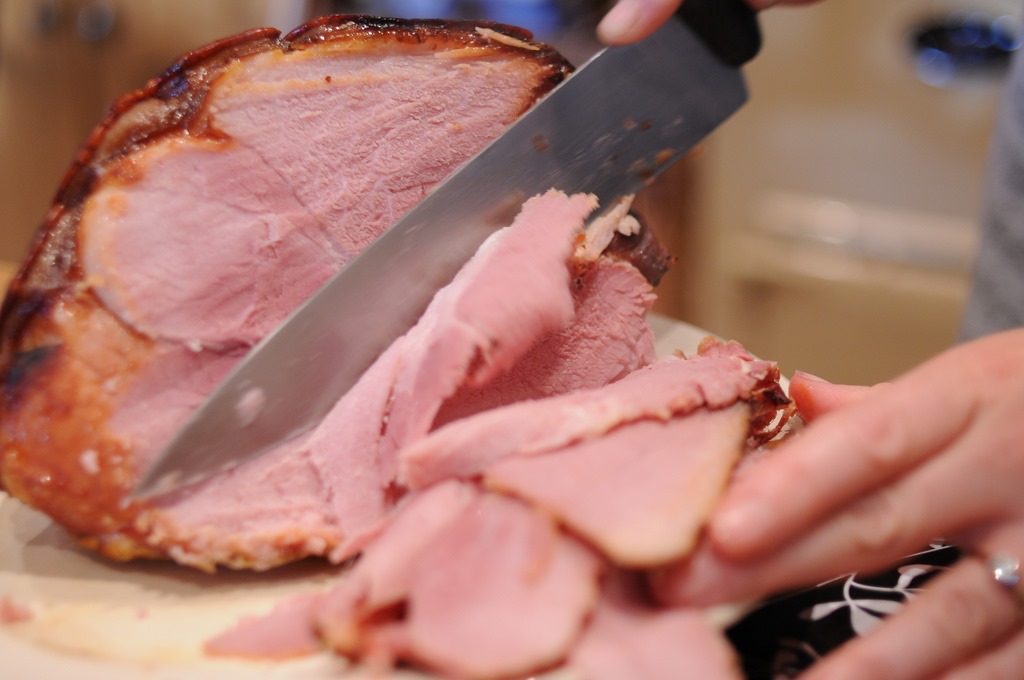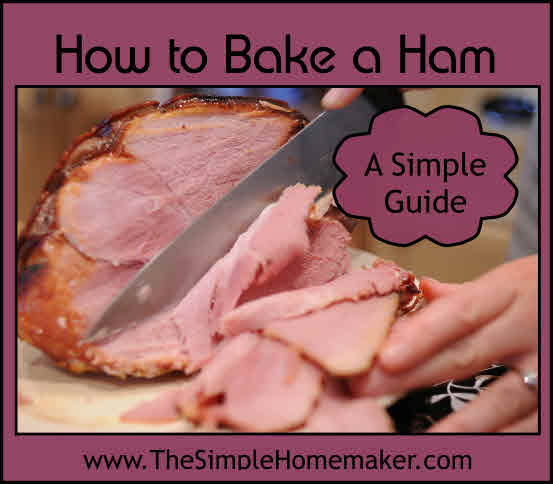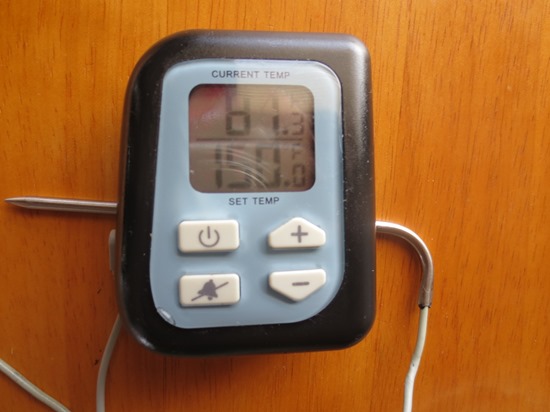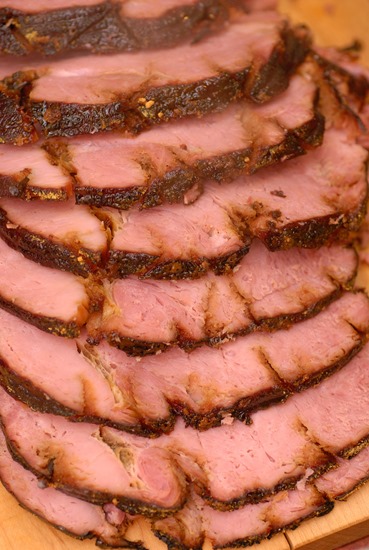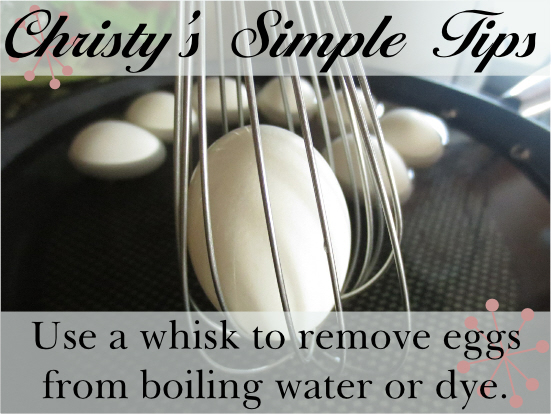I love a good, juicy ham on Easter and Christmas (and any day in between). Too often the hams we’ve had are dry, expensive and sickeningly sweet, even when we bought the high-priced, big name hams from the ham store. It’s enough to make a person sit down and cry into her taters. Therefore, we took it upon ourselves to find the cheapest, tastiest method of preparing ham that we could…just for you. You’re welcome.
How to Bake a Ham – A Simple Guide
What do I need?
- a ham
- pan
- one cup water (optional)
- aluminum foil
- meat thermometer
- oven
- optional ingredients for an optional sauce – ours only requires brown sugar and a sauce pan
Which ham should I buy?
The most convenient ham is, naturally, the spiral-sliced. Our experience with spiral cut, however, is that they dry out very easily. Because they are already cut, the heat has more surface area from which to draw moisture. Nothing can prevent moisture loss to some extent, not even the reams of aluminum foil we use to try and prevent its drying out.
For that reason, we buy unsliced ham, which, to our delight, is cheaper. I like the shank, because it is often the cheapest of all and not too difficult to slice. You can also grab yourself a nice butt which will work just as well for the same price or just a few pennies a pound more, depending on your store. According to our old butcher, the shank and butt are essentially the whole ham (which is the leg) chopped in half to form the separate cuts. With such little difference, I go for whichever is cheaper. (Here’s more than you ever wanted to know about ham cuts.)
Watch for a sale around the major holidays and you’ll really score big with your ol’ pigskin.
How do I cook the ham?
- Preheat your oven to 350.
- Put the ham in a pretty (okay, so it doesn’t have to be pretty) roasting pan with the bone side down, fat side up.
- Add one cup of water to the pan. (Some experts say not to do this, but I do it…so there, experts!)
- Cover it completely with aluminum foil. But aluminum foil will kill you! I know, but this ham is so juicy, you’ll die happy.
- Cook to the proper temperature as explained below, and immediately remove it from the oven.
- Let the ham rest covered for 20 minutes or so before slicing, so the juices redistribute throughout the ham.
How long do I cook the ham?
If the ham is pre-cooked, heat it to an internal temperature of 110-140 (Fahrenheit) and pull it from the oven, depending on how warm you want your ham. (If it’s fully cooked, you can theoretically eat it cold.)
If the ham is not pre-cooked or only partially cooked, heat it to 150-155 (Fahrenheit) and pull immediately. I know the meat police say 160, but it will continue cooking 5-10 degrees after you pull it. I pull at 150. If you wait for 160, you may have a dry ham. You’ve been warned.
Use a meat thermometer! Insert it well into the meat, but not touching the bone. if you don’t have a meat thermometer and you cook meat, buy one. If you don’t want to buy one, you’ll be cooking roughly 20-30 minutes per pound, but I won’t guarantee that your stove doesn’t run hot and that you won’t be eating a football. In that case, I wash my hands of your ham.
This is my meat thermometer:
You can buy one here.
What do I do about a glaze?
I won’t even go there! Okay, maybe just a little. There are as many ham glaze recipes out there as there are cooks to prepare them. Personally, I don’t like to be knocked out by an overwhelming shot of sugar, bourbon, cloves, or pineapple when all I really want is a nice big mouthful of meat. I want to taste the ham! Is that so wrong?!
Are you with me? It’s okay if you’re not, because you can do a quick search on any recipe site for half a gazillion glazes. Here are 68 glaze recipes from my favorite recipe site, AllRecipes.com. Read the reviews and pick your favorite…but might I recommend you keep it simple?
Because my husband likes the option of a subtle sweetness with his ham, and others in my family like the option of eating ham without going into a diabetic coma, this is the method he whipped up:
The Simple Homemaker’s Husband’s Simple Ham Sauce
- Pour the pan drippings into a saucepan.
- Add 1/4 cup or so of brown sugar or honey (depending on how sweet you want it and how much juice you have).
- Heat it on the stove stirring to dissolve the sugar or honey, and testing for the sweetness level you’re looking for.
- Adjust with water if it’s too salty or thick, and sugar or honey if you want a sweeter juice. Taste as you go and adjust gradually.
- Serve it on the side as an optional au jus.
It is simple and delicious, but doesn’t coat the ham with sugar, which many people in my family can’t (or won’t) eat.
How do I slice a non-sliced ham?
- Insert your knife parallel to the bone and cut entirely around it. (Remember, the two L’s in the word “parallel” are parallel to each other, if you forgot your basic math.)
- Slice perpendicular to the bone to make nice slices that should fall away from the bone. (You will be cutting into the length of the bone, not the end…obviously.) Do this on either side of the bone.
There will be quite a bit of meat left on the bone, just as with the store-bought spiral cuts. I like to gnaw on this when nobody’s looking remove this meat later with a small knife and use it for any number of recipes needing diced ham, including scrambled eggs, bean or potato soups, fried rice, quiche, breakfast potatoes, salad.
Save the bone and toss it into a soup, crock of beans, or pot of jambalaya.
Here’s the boring printable version of how to bake a ham:
- a ham
- pan
- one cup water (optional)
- aluminum foil
- meat thermometer
- oven
- optional ingredients for an optional sauce – ours only requires brown sugar and a sauce pan
- Preheat your oven to 350.
- Put the ham in a pretty (okay, so it doesn’t have to be pretty) roasting pan with the bone side down, fat side up.
- Add one cup of water to the pan. (Some experts say not to do this, but I do it…so there, experts!)
- Cover it completely with aluminum foil. But aluminum foil will kill you! I know, but this ham is so juicy, you’ll die happy.
- Cook to 150 using a meat thermometer if your ham is uncooked or partially cooked. If it’s fully cooked, warm it to your desired temperature, but no warmer than 140 or you may dry it out. Blech.
- Immediately remove it from the oven.
- Let the ham rest covered for 20 minutes or so before slicing, so the juices redistribute throughout the ham.
- Remove the drippings to a saucepan over low heat. Stir in 1/4 cup brown sugar or honey, taste, and add more if desired to sweeten the juices to your desired sweetness. Serve on the side so everybody is happy!
I hope your ham turns out as juicy and delicious (and affordable) as ours! Good luck!
Let me know what you think, including your best pointers on how to bake a ham…a simple ham.
But if you talk about scoring the outside in cross hatches, stuffing cloves all over, dousing it in bourbon, and then adding pineapple and maraschino cherries, I’ll know you didn’t really read this post and don’t embrace my “simple” philosophy. (Wink.)
I’m embarrassed to admit that I have no pictures of our own hams. Years of ham baking and experimentation, and nothing to show for it but full tummies. Special thanks to all the photographers credited above…but our hams look juicier. A-hem.

